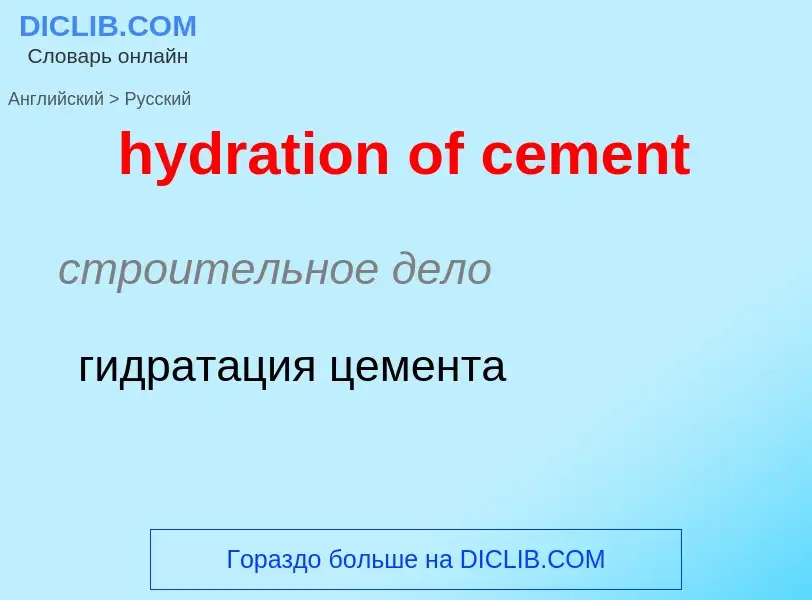Translation and analysis of words by ChatGPT artificial intelligence
On this page you can get a detailed analysis of a word or phrase, produced by the best artificial intelligence technology to date:
- how the word is used
- frequency of use
- it is used more often in oral or written speech
- word translation options
- usage examples (several phrases with translation)
- etymology
hydration of cement - translation to russian
строительное дело
гидратация цемента
Definition
.
Wikipedia

A cement is a binder, a chemical substance used for construction that sets, hardens, and adheres to other materials to bind them together. Cement is seldom used on its own, but rather to bind sand and gravel (aggregate) together. Cement mixed with fine aggregate produces mortar for masonry, or with sand and gravel, produces concrete. Concrete is the most widely used material in existence and is behind only water as the planet's most-consumed resource.
Cements used in construction are usually inorganic, often lime or calcium silicate based, which can be characterized as hydraulic or the less common non-hydraulic, depending on the ability of the cement to set in the presence of water (see hydraulic and non-hydraulic lime plaster).
Hydraulic cements (e.g., Portland cement) set and become adhesive through a chemical reaction between the dry ingredients and water. The chemical reaction results in mineral hydrates that are not very water-soluble and so are quite durable in water and safe from chemical attack. This allows setting in wet conditions or under water and further protects the hardened material from chemical attack. The chemical process for hydraulic cement was found by ancient Romans who used volcanic ash (pozzolana) with added lime (calcium oxide).
Non-hydraulic cement (less common) does not set in wet conditions or under water. Rather, it sets as it dries and reacts with carbon dioxide in the air. It is resistant to attack by chemicals after setting.
The word "cement" can be traced back to the Ancient Roman term opus caementicium, used to describe masonry resembling modern concrete that was made from crushed rock with burnt lime as binder. The volcanic ash and pulverized brick supplements that were added to the burnt lime, to obtain a hydraulic binder, were later referred to as cementum, cimentum, cäment, and cement. In modern times, organic polymers are sometimes used as cements in concrete.
World production is about four billion tonnes per year, of which about half is made in China. If the cement industry were a country, it would be the third largest carbon dioxide emitter in the world with up to 2.8 billion tonnes, surpassed only by China and the United States. The initial calcination reaction in the production of cement is responsible for about 4% of global CO2 emissions. The overall process is responsible for about 8% of global CO2 emissions, as the cement kiln in which the reaction occurs is typically fired by coal or petroleum coke because a luminous flame is required to heat the kiln by radiant heat transfer. As a result, the production of cement is a major contributor to climate change.




![The National Cement Share Company of [[Ethiopia]]'s new plant in [[Dire Dawa]]. The National Cement Share Company of [[Ethiopia]]'s new plant in [[Dire Dawa]].](https://commons.wikimedia.org/wiki/Special:FilePath/Factory of National Cement Share Company.jpg?width=200)
![Clinker]] nodules produced by sintering at 1450 °C. Clinker]] nodules produced by sintering at 1450 °C.](https://commons.wikimedia.org/wiki/Special:FilePath/LDClinkerScaled.jpg?width=200)
![page=[https://archive.org/details/isbn_9781616144814/page/190 190]}}</ref> page=[https://archive.org/details/isbn_9781616144814/page/190 190]}}</ref>](https://commons.wikimedia.org/wiki/Special:FilePath/William Aspdin Radford cyclopedia Volume 1.jpg?width=200)
 (cropped).jpg?width=200)


